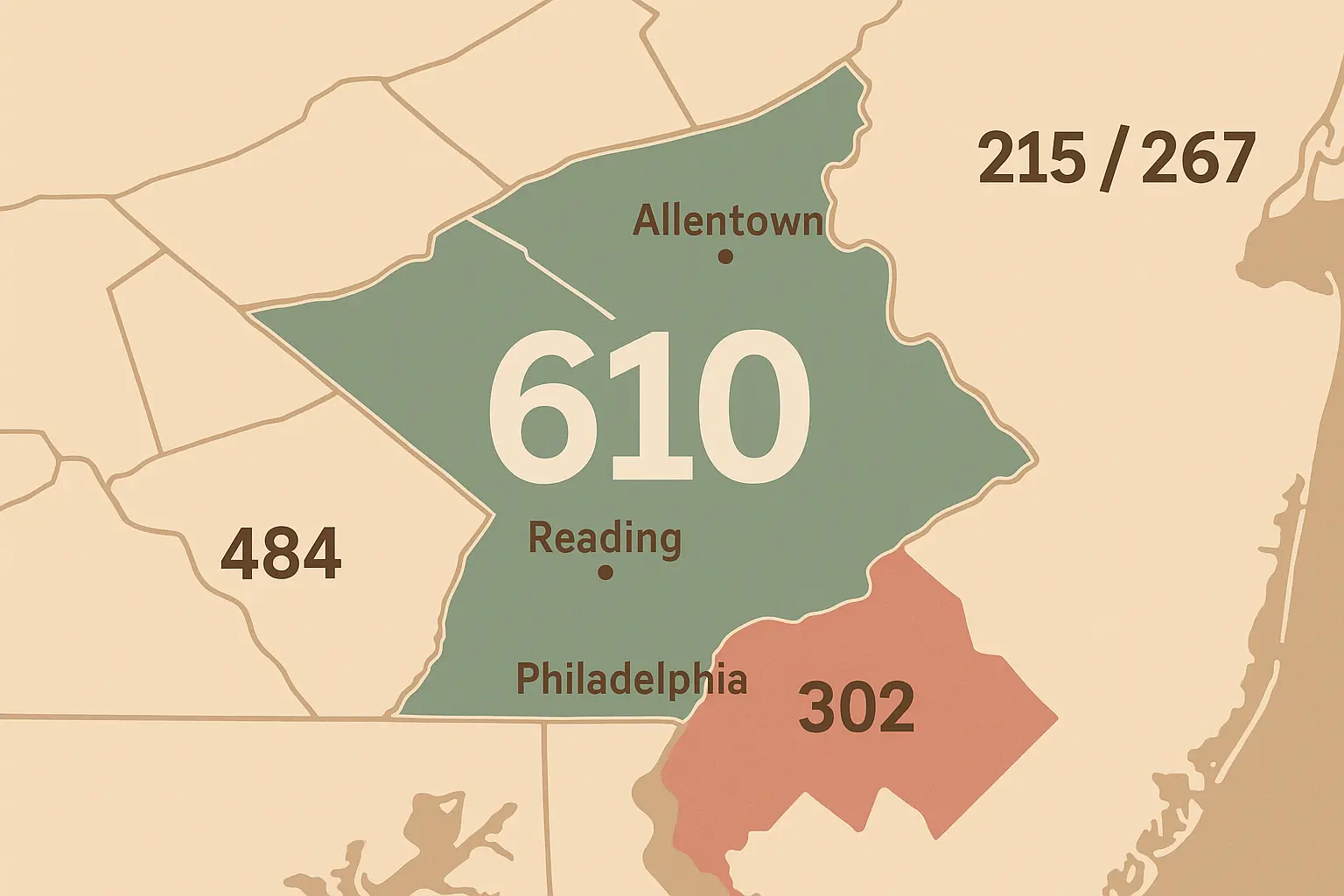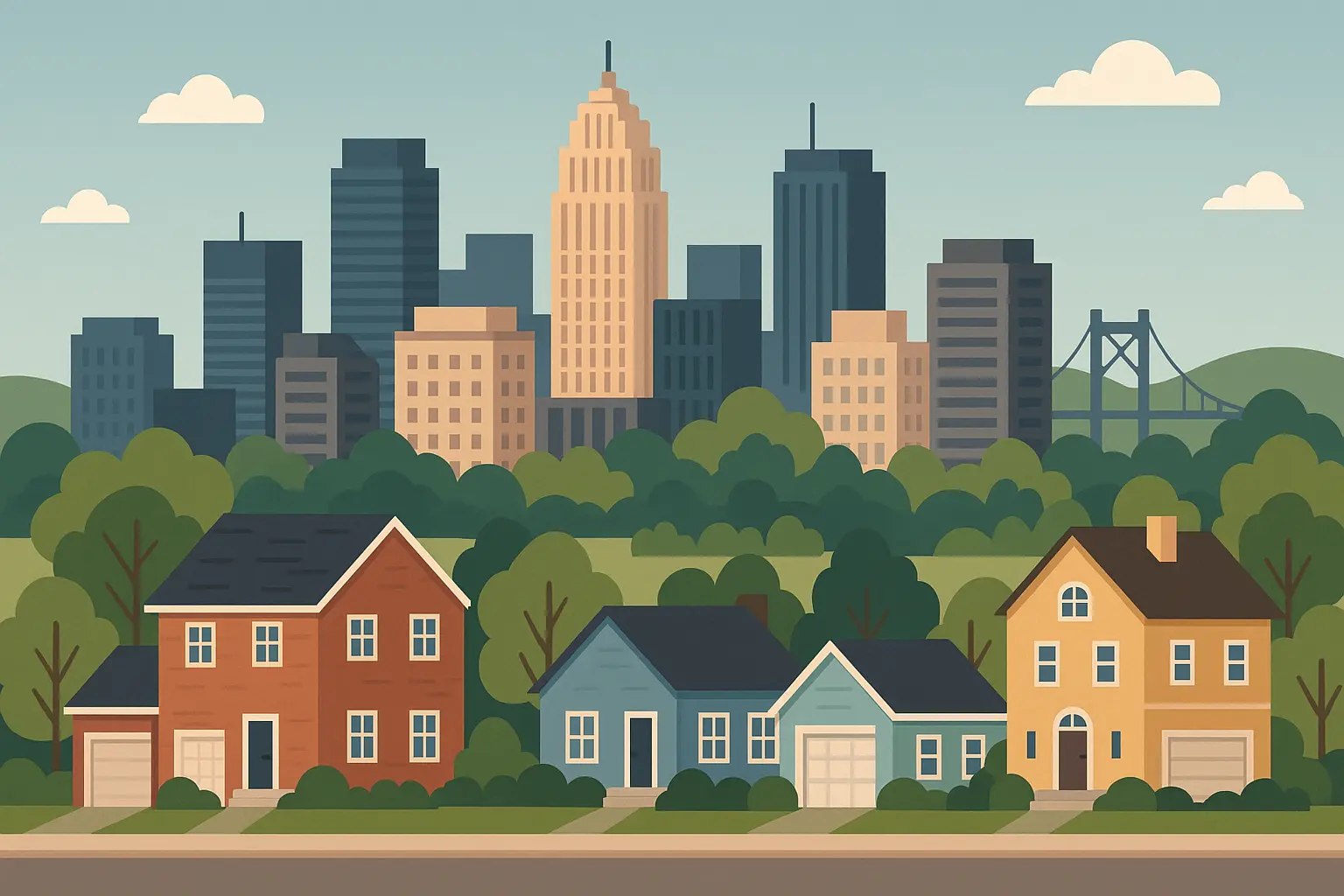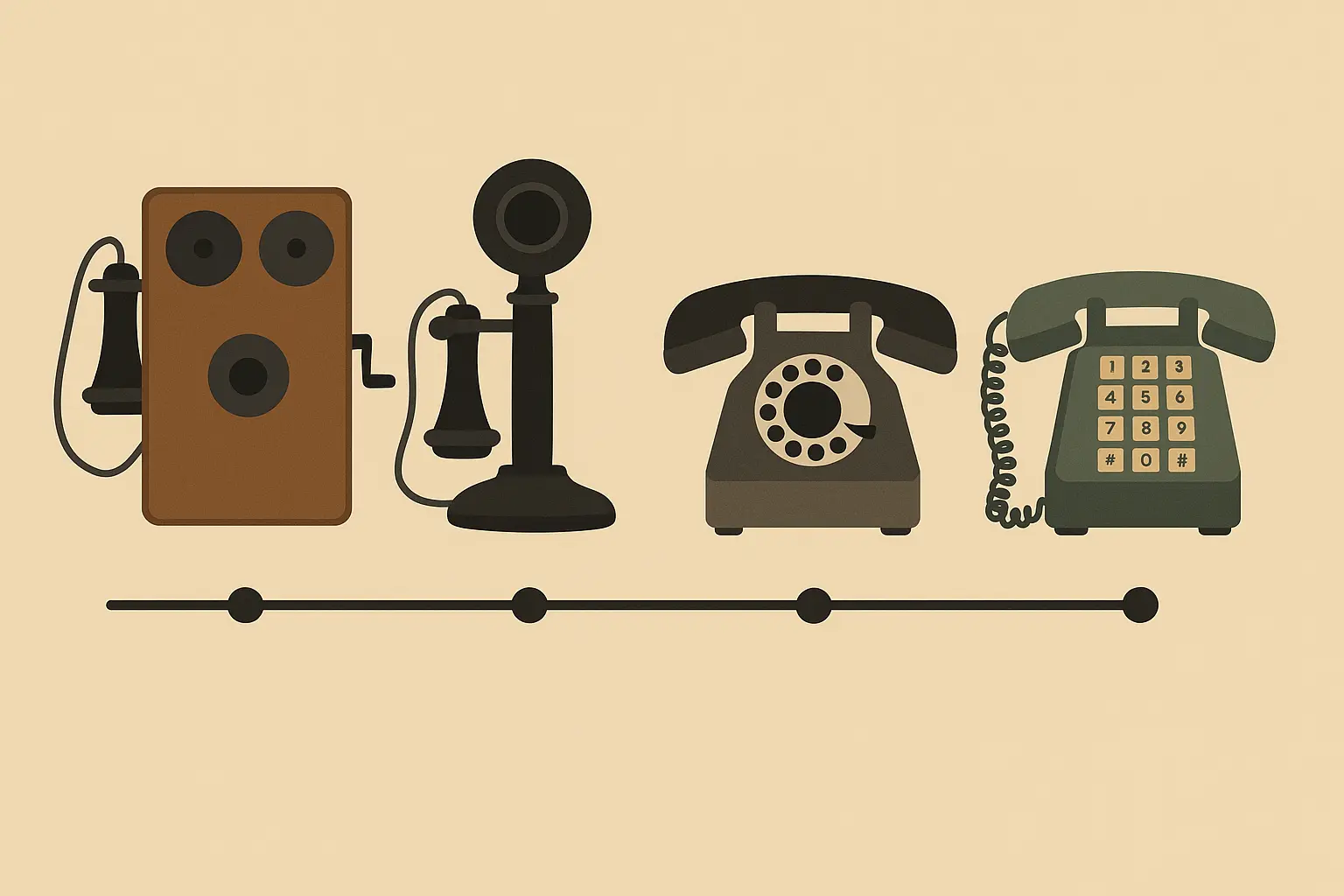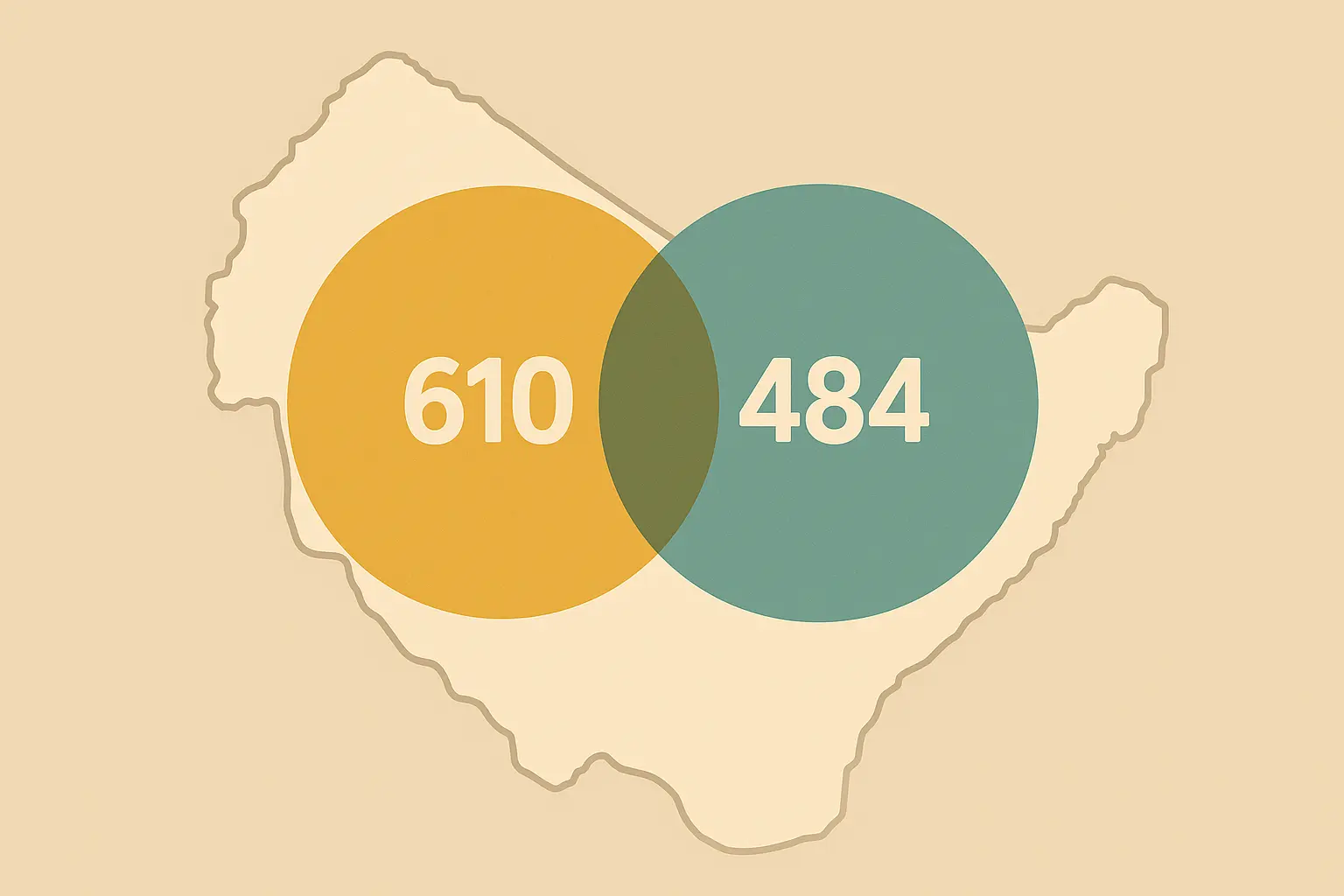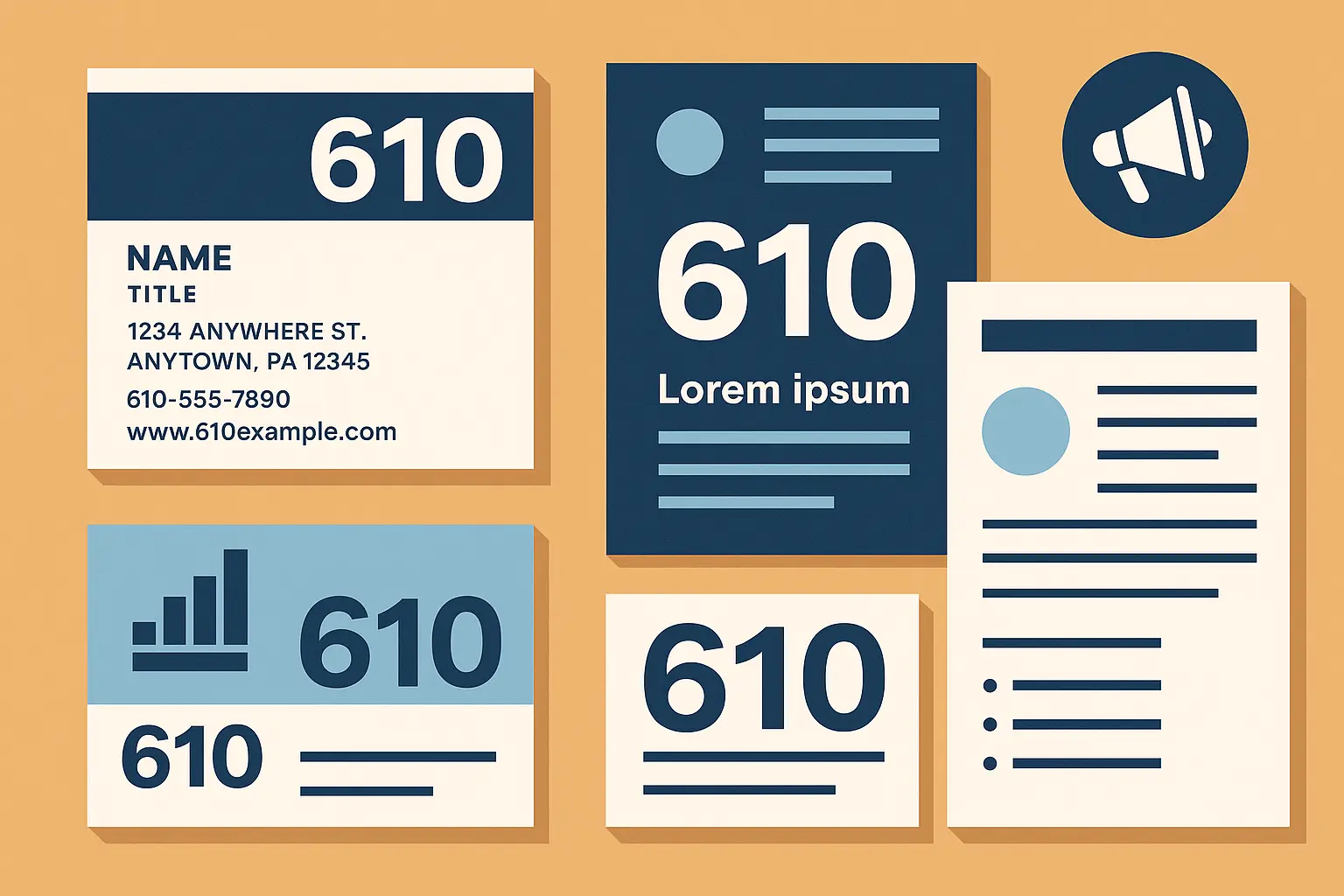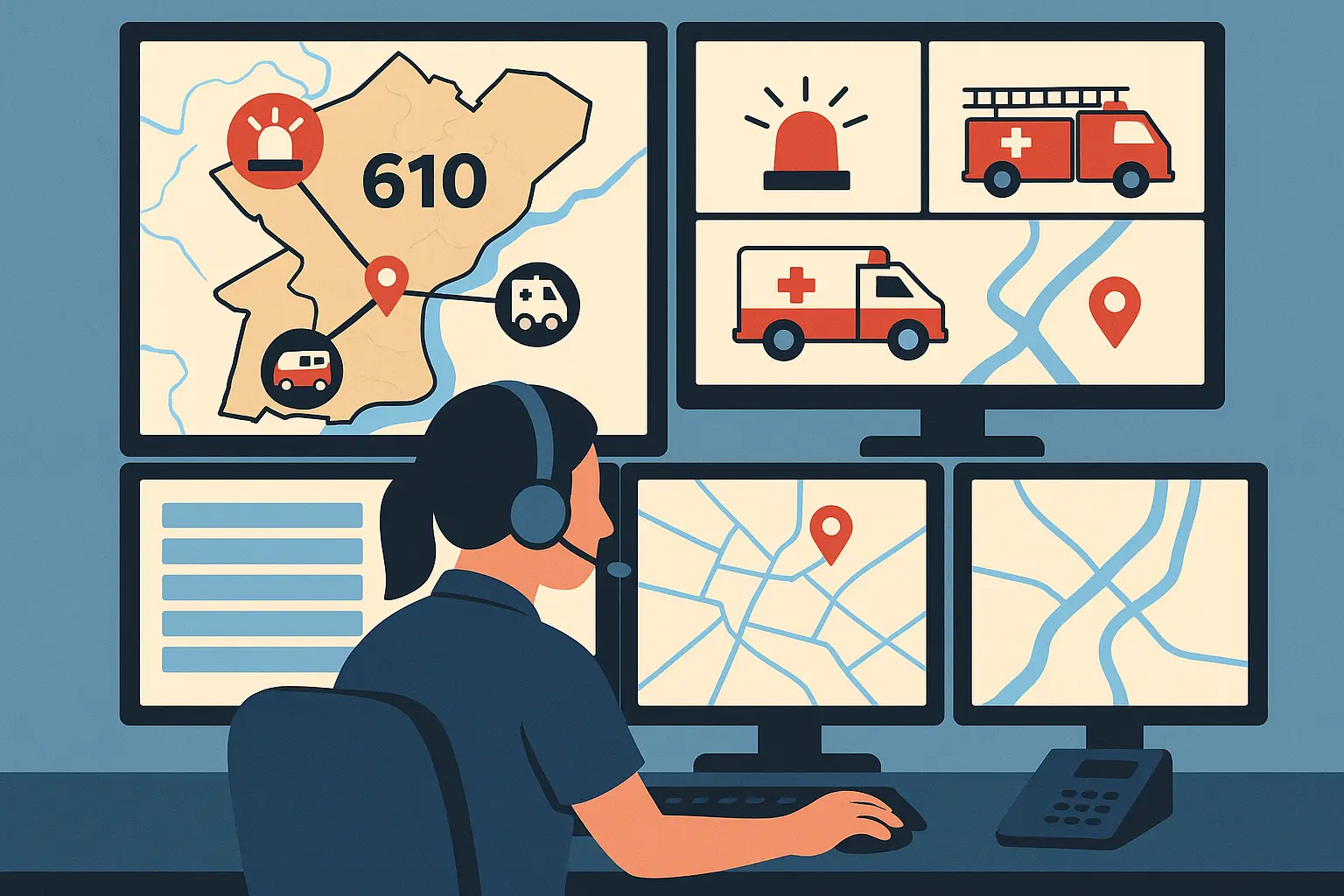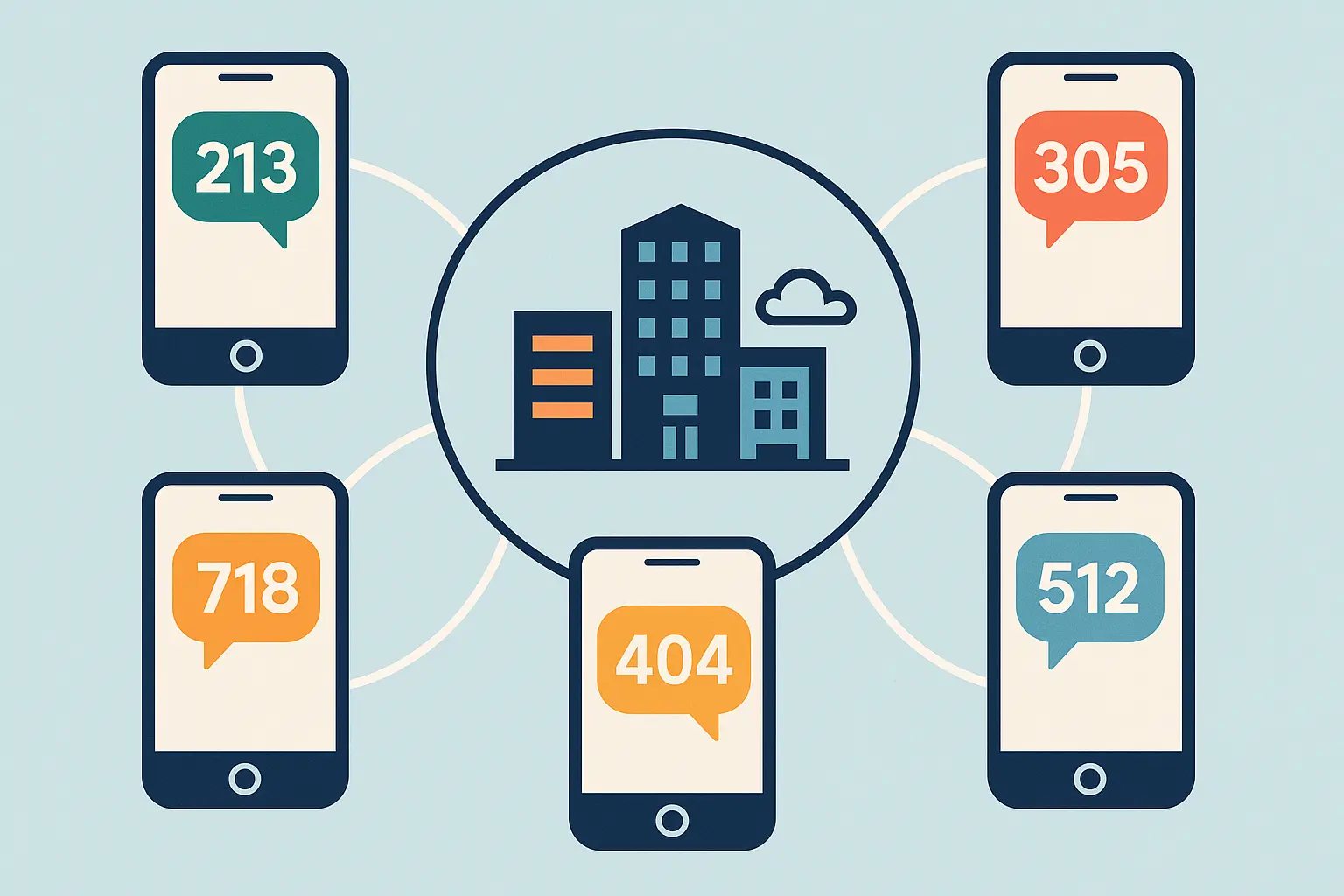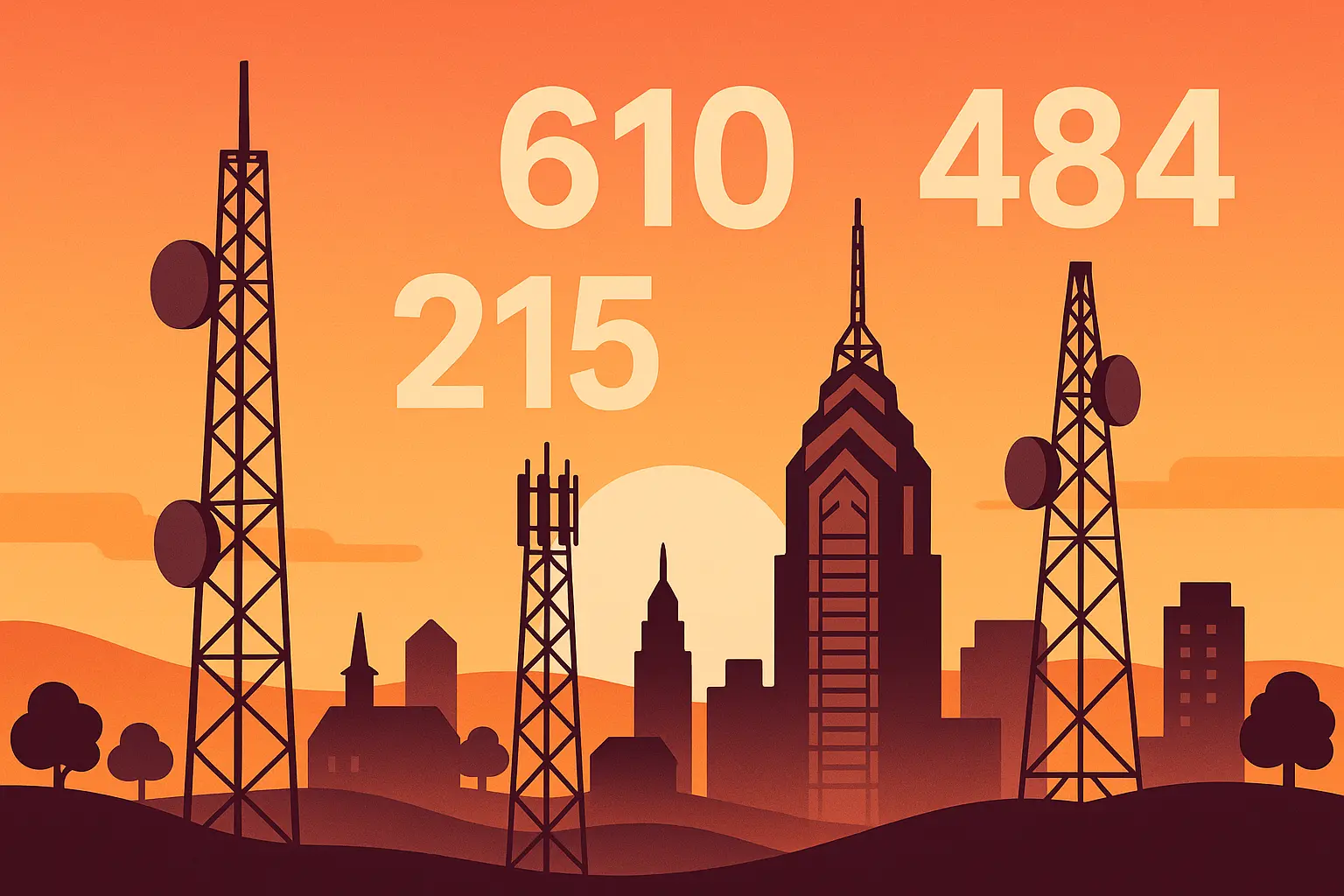Living in southeastern Pennsylvania for years, I’ve learned that your 610 area code tells a story. It’s not just three digits—it’s a badge of local identity that can make or break a business deal, help emergency responders find you faster, and even influence where people think you’re from. This guide reveals everything from the 1994 split that created 610 to why your business might benefit from keeping that coveted number over a newer 484 one. Whether you’re a longtime resident or new to the Lehigh Valley region, you’ll discover how this area code shapes everything around here.
So who exactly lives in 610 territory? About 2.5 million people spread across six counties according to demographic data from ZipAtlas—making it one of Pennsylvania’s busiest area codes outside Philly proper.
Table of Contents
Table of Contents
-
Where Your 610 Number Actually Reaches (And Why It Matters)
-
The 1994 Split That Changed Everything
-
Why 484 Numbers Exist (And How They Work With 610)
-
What Your Area Code Says About Your Business
-
The Technical Side Most People Never Think About
-
How Modern Services Handle Multi-Area Code Challenges
-
Final Thoughts
TL;DR
-
The 610 area code covers major Pennsylvania cities like Allentown, Bethlehem, Reading, and Easton, serving over 1.2 million residents across six counties
-
Created in 1994 when the original 215 split due to suburban growth and new tech adoption
-
The 484 overlay was added in 1999—both codes serve the same area, so you need to dial 10 digits for everything now
-
Local businesses often prefer 610 numbers because customers see them as more established than 484
-
Emergency services use GPS-powered systems that work across multiple counties in the region
-
Modern tools help manage the complexity of operating across multiple area codes
Where Your 610 Number Actually Reaches (And Why It Matters)
Your 610 isn’t just random digits—it represents a specific slice of southeastern Pennsylvania that includes some of the state’s most economically important regions. From Allentown’s urban center to suburban communities spreading across six counties, understanding this footprint helps explain why certain businesses thrive and how local identity connects to your phone number.
The Cities and Counties That Make Up 610 Territory
When I tell people I’m from the 610 area, they usually know I’m somewhere near Philadelphia but not quite in the city itself. The territory spans Lehigh, Northampton, Berks, Chester, Delaware, and Montgomery counties—creating a diverse landscape from Allentown’s downtown core to quiet suburban neighborhoods that have exploded in growth over recent decades.
Allentown stands as the heavyweight champion here. As Lehigh County’s seat, it anchors what locals call the Lehigh Valley region. But don’t sleep on Bethlehem—this city carries serious historical weight with its steel industry heritage. Reading rounds out the major players as Berks County’s commercial hub.
The population density tells an interesting story. We’re talking about 1.2 million people spread across this region, making 610 one of Pennsylvania’s most populous area codes outside Philadelphia proper. That’s a lot of phones ringing with those three digits.
Here’s the breakdown:
-
Lehigh County (Allentown, Bethlehem) – The heavyweight with healthcare and manufacturing
-
Northampton County (Easton, Nazareth) – Logistics and education hub
-
Berks County (Reading, Wyomissing) – Agriculture and retail central
-
Chester County (West Chester, Coatesville) – Pharma money and finance
-
Delaware County (Media, Chester) – Healthcare and tech companies
-
Montgomery County (Norristown, Pottstown) – Business services galore
Consider a small marketing agency based in Allentown. When they cold-call prospects in Reading or West Chester, that familiar area code immediately signals they’re local business, potentially boosting their callback rates by 15-20% compared to using an out-of-area number.
For businesses managing communications across multiple locations, understanding proper phone number formatting becomes crucial when coordinating with national clients or vendors.
Urban Centers vs. Suburban Sprawl
The 610 area perfectly captures Pennsylvania’s evolution from industrial centers to suburban communities. While cities like Allentown and Reading provide traditional urban environments, much of the territory consists of suburban developments that experienced massive growth, creating unique challenges for phone systems and local business operations.
Here’s what strikes me about this landscape: it’s not just urban or just suburban. You’ve got legitimate city centers in Allentown and Reading, but drive fifteen minutes in any direction and you’re in suburban territory that looks completely different.
This mix creates interesting dynamics. The urban areas need different phone infrastructure than the suburban sprawl. Emergency services coordinate across vastly different population densities. Businesses serve customers who might live in downtown Allentown or rural Berks County—sometimes both.
How 610 Connects (And Conflicts) With Neighboring Area Codes
Understanding the relationship between 610 and its neighboring area codes reveals the complex phone puzzle of southeastern Pennsylvania. The boundary with Philadelphia’s 215 isn’t just geographic—it represents economic and cultural divisions that affect everything from business relationships to emergency service coordination.
The 215 area code sits right next to 610, serving Philadelphia proper and its immediate surroundings. This creates a natural boundary that matters more than you might think. If you’re running a business here, you’re constantly dealing with customers and suppliers who have 215 numbers.
Originally, 215 covered way more territory before 610 came along in 1994. That split reflected southeastern Pennsylvania’s growing phone needs as suburban populations exploded and new technologies (fax machines, early cell phones) demanded more numbers.
The region’s phone landscape keeps evolving, with “the remaining supply of numbers in the current 610/484 area codes nearly exhausted” according to 6ABC News, leading to the introduction of the 835 area code as early as September 2022.
The 484 Overlay Situation Everyone Had to Learn
The introduction of 484 as an overlay fundamentally changed how residents make phone calls, requiring everyone to dial ten digits even for local calls. This technical solution to number exhaustion created both practical challenges and interesting social dynamics around area code preferences that persist today.
Here’s where things get interesting (and slightly annoying). In 1999, the 484 area code was introduced as an overlay to 610. Both codes serve the exact same geographic territory, which solved the number shortage problem but created new headaches.
The biggest change? You now have to dial ten digits for every call, even local ones. I remember the adjustment period—it felt weird dialing the area code to call someone three blocks away. Public education campaigns ran constantly, trying to help everyone adapt.
New phone numbers in the region get assigned either 610 or 484, depending on what’s available and your provider’s policies. But here’s the kicker—many people still prefer 610 numbers for reasons I’ll explain later.
Businesses operating across multiple area codes often need to forward text messages to email to ensure they don’t miss important communications from customers using different area codes.
The 1994 Split That Changed Everything
The creation of 610 in 1994 wasn’t just a technical adjustment—it represented a fundamental shift in how southeastern Pennsylvania organized its phone systems. This split from the original 215 reflected broader changes in American communication patterns, suburban development, and early adoption of technologies that would reshape how we connect.
Life Before 610 (When 215 Ruled Everything)
Before 1994, the entire southeastern Pennsylvania region operated under a single 215 area code that had served the area since 1947’s North American Numbering Plan implementation. This system worked fine for decades, but rapid suburban development, business growth, and the proliferation of fax machines and early mobile phones created unprecedented demand that the old system couldn’t handle.
Picture this: before 1994, everyone from Center City Philadelphia to Reading to Allentown shared the same 215 area code. The system worked when it launched in 1947, but by the early 1990s, it was breaking down.
What drove the change? Suburban development was exploding. Businesses were growing rapidly. Fax machines were everywhere (remember those?). Early mobile phones were becoming more common. Each of these trends demanded new phone numbers, and 215 was running out of available combinations.
The geographic split made sense when you looked at calling patterns. People in the western and northern suburbs (what became 610 territory) called each other more often than they called downtown Philadelphia. The boundary reflected both population distribution and how people actually used their phones.
Implementation Challenges Nobody Talks About
Transitioning an entire region to a new area code required massive coordination between phone companies, businesses, and government agencies. The technical and logistical challenges of ensuring service continuity while changing fundamental dialing patterns affected everything from emergency services to business operations.
The transition to 610 wasn’t just flipping a switch. Phone companies had to coordinate extensively to ensure nobody lost service. Businesses had to update their marketing materials, letterheads, and customer databases. Government agencies needed new phone systems.
I’ve talked to people who lived through the transition, and they remember the confusion. Which numbers were changing? When did the new dialing patterns take effect? How long did they have to update their business cards?
The coordination was insane. Emergency services had to ensure 911 calls would route correctly. Businesses with multiple locations needed to figure out which sites would keep 215 and which would get 610. The whole process took months of planning and implementation.
Area Code Transition Checklist:
-
Update all business marketing materials
-
Reprogram phone systems and voicemail
-
Notify customers of number changes
-
Update emergency contact information
-
Coordinate with phone companies
-
Test all automated dialing systems
-
Train staff on new dialing procedures
During major transitions like this, businesses often need to set up automated message forwarding systems to ensure customer communications reach the right departments during the changeover period.
Why 484 Numbers Exist (And How They Work With 610)
The 484 overlay system represents a more sophisticated approach to managing number exhaustion than the original 610/215 split. Rather than dividing territory geographically, the overlay allows both area codes to serve the same region, creating interesting social and business dynamics around area code preferences while solving the technical problem of running out of available phone numbers.
The Number Shortage Crisis of the Late 1990s
By the late 1990s, even the relatively new 610 was approaching capacity as the region continued its rapid growth. The introduction of 484 as an overlay solution represented a shift in phone planning philosophy, prioritizing customer convenience over geographic simplicity while addressing the fundamental challenge of finite number combinations.
Even after the 1994 split, southeastern Pennsylvania kept growing. The 610 area was adding residents, businesses, and phone lines faster than anyone anticipated. By the late 1990s, we were facing another number shortage.
The solution this time was different. Instead of splitting the territory again (which would have been geographically awkward), phone planners introduced the 484 overlay in 1999. Both 610 and 484 would serve the same geographic area, effectively doubling the available phone numbers.
This approach prioritized customer convenience. Nobody had to change their existing phone number. But it came with a trade-off: everyone had to start dialing ten digits for all calls, including local ones.
How the Dual-Code System Actually Works
Operating under both 610 and 484 area codes creates unique practical considerations for residents and businesses. From number assignment policies to customer perceptions, the overlay system influences everything from marketing strategies to emergency service coordination.
Here’s how it works in practice: when you get a new phone number in the region, your provider assigns either 610 or 484 based on availability. You can’t choose (unless you’re willing to pay extra or get lucky with timing).
Both area codes connect to the same local calling area. A 610 number can call a 484 number as a local call, and vice versa. The ten-digit dialing requirement applies to everyone—even calling your next-door neighbor requires the area code.
For businesses, this creates interesting dynamics. Many prefer 610 numbers because customers perceive them as more established. Real estate agents use area codes as quick geographic identifiers. Emergency services had to upgrade their systems to handle the dual-code situation seamlessly.
Consumer Preferences and Perceptions
The coexistence of 610 and 484 numbers has created subtle but persistent social hierarchies around area code preferences. Local businesses often view 610 numbers as more valuable for marketing and customer trust, while different demographic groups show varying levels of attachment to specific area code designations.
There’s definitely a hierarchy in people’s minds between 610 and 484 numbers. Established businesses often fight to keep their 610 numbers, viewing them as marks of local authenticity and longevity. Customers sometimes express more trust in businesses with 610 numbers, seeing them as more established and community-connected.
This preference isn’t universal, though. Older residents tend to care more about maintaining their original 610 numbers, while younger people show less attachment to specific area codes. Different industries also have varying perspectives—some see any local area code as equally valuable, while others specifically market their 610 heritage.
The generational divide is particularly interesting. People who lived through the original 215-to-610 transition often have strong preferences for 610. Those who grew up with cell phones and moved frequently care less about area code identity.
My friend owns two pizza places—one with a 610 number, one with 484. Guess which one gets more calls? The 610 location outsells the other by nearly 25%, and they’re identical otherwise.
What Your Area Code Says About Your Business
In the 610 region, your area code functions as more than just a phone identifier—it serves as a subtle but powerful marketing tool that influences customer perceptions, local credibility, and business positioning. Understanding these dynamics helps explain why some companies invest significant effort in maintaining specific area codes while others adapt more flexibly to the dual-code environment.
The Local Credibility Factor
Businesses operating in the region often leverage their phone numbers as indicators of local presence and community connection. This phenomenon reflects broader patterns of consumer behavior where local identity influences purchasing decisions, particularly in service industries where trust and community relationships drive customer loyalty.
Your phone number tells a story about your business before you even answer the call. In this region, that story often includes assumptions about how long you’ve been around, how connected you are to the local community, and whether you’re a “real” local business or an outsider.
I’ve seen businesses specifically request 610 numbers when setting up new lines, even when 484 numbers are more readily available. The reasoning? Customer recognition and implied credibility. A 610 number suggests you’ve been part of the community longer, that you understand local needs and preferences.
This matters particularly for service-based businesses—contractors, real estate agents, healthcare providers, restaurants. When customers are choosing between similar options, the familiar 610 code can provide a subtle competitive advantage.
The economic strength of the region supports this preference for local businesses, with the median household income reaching $101,974 according to ZipAtlas demographic data, indicating a customer base with significant purchasing power for local services.
Marketing and Brand Identity Considerations
The choice between 610 and 484 numbers involves strategic marketing considerations that extend beyond simple phone needs. Companies must balance practical availability with brand positioning, customer expectations, and long-term business goals, creating complex decision-making processes around something as basic as a phone number.
Marketing professionals here face interesting decisions around phone numbers. Do you prominently display your area code in advertising? How do you handle the situation if you have multiple locations with different area codes? What message does your area code send about your target market?
Some businesses lean into their 610 identity, using it as a badge of local authenticity. Others downplay area codes entirely, focusing on other aspects of their local connection. The strategy often depends on your target demographic and industry.
Real estate professionals face particularly complex dynamics. A 610 number might suggest deep local knowledge to potential clients, but it could also limit perceived geographic expertise if you serve multiple area code regions.
Customer Trust and Recognition Patterns
Consumer behavior in the region reveals interesting patterns around area code preferences that influence business success. These preferences reflect deeper psychological associations between phone numbers and business legitimacy, creating measurable impacts on customer response rates, trust levels, and initial contact decisions that smart businesses factor into their phone strategies.
Customer behavior around area codes is more nuanced than you might expect. Research in similar markets shows that consumers often make split-second judgments about business legitimacy based on phone numbers, and the 610 area follows these patterns.
Local consumers frequently express greater initial trust in businesses with 610 numbers, particularly for services involving home visits, financial transactions, or ongoing relationships. The 610 code carries implied credibility—it suggests the business has been around long enough to have secured one of the “original” numbers.
This doesn’t mean 484 numbers doom businesses to failure. But it does mean companies with newer area codes might need to work slightly harder to establish local credibility through other means—community involvement, local partnerships, or emphasizing other aspects of their local connection.
The Technical Side Most People Never Think About
Behind every 610 call lies a complex phone infrastructure that most users never consider. From number portability systems to emergency service coordination, the technical architecture supporting this region involves sophisticated network management, redundancy planning, and cross-jurisdictional coordination that ensures reliable service across diverse geographic and demographic landscapes.
Network Infrastructure and Provider Coordination
Multiple major phone carriers serve the region, each managing different aspects of number allocation and service delivery while maintaining interoperability across their networks. This complex provider landscape requires sophisticated coordination for everything from number portability to emergency services, creating technical challenges that influence service quality and customer options.
The 610 area operates on complex phone infrastructure that involves multiple major carriers—Verizon, AT&T, T-Mobile, and various regional providers. Each manages different pieces of the puzzle while ensuring everything works together seamlessly.
Number portability adds another layer of complexity. When you want to switch carriers while keeping your 610 number, the process involves coordination between multiple network systems. It’s not just changing a database entry—it requires routing updates, billing system changes, and service continuity planning.
Behind the scenes, your 610 call might bounce between three different phone companies before reaching its destination. You’ll never notice, but there’s a lot of coordination happening to make that simple call work.
|
Technical Component |
Function |
Complexity Level |
Impact on Users |
|---|---|---|---|
|
Number Portability Database |
Tracks number ownership |
High |
Seamless carrier switching |
|
E911 Location Services |
Emergency call routing |
Very High |
Life-saving accuracy |
|
Network Interconnection |
Cross-carrier communication |
High |
Universal connectivity |
|
Billing Integration |
Multi-carrier coordination |
Medium |
Accurate service charges |
|
Fraud Prevention |
Security monitoring |
High |
Protection from scams |
Emergency Services Integration Across Counties
The region’s emergency services operate sophisticated E911 systems that must coordinate across multiple counties and jurisdictions while providing accurate location information for both landline and mobile callers. This technical complexity reflects the challenges of serving diverse geographic territories with varying population densities and administrative boundaries.
Emergency services here face unique technical challenges. The area code spans multiple counties and dozens of municipalities, each with their own emergency response systems that must coordinate seamlessly.
When you dial 911 from a 610 number, the system instantly knows exactly where you are—even if you’re lost in some suburban development where all the streets look the same. Modern E911 systems can pinpoint caller locations with impressive accuracy, even for mobile devices.
The cross-jurisdictional coordination required is substantial. A 911 call from a 610 number might need routing to Lehigh County emergency services, Berks County dispatch, or any number of municipal departments depending on the caller’s exact location. The system must identify not just where the caller is, but which emergency services have jurisdiction and the fastest response capability.
GPS-enabled location services have revolutionized emergency response in the region. When someone calls 911 from a mobile device, the system can provide emergency responders with precise coordinates, which is particularly valuable in rural areas or large suburban developments where traditional addressing might be confusing.
Number Portability and Carrier Switching
The ability to transfer 610 numbers between carriers involves complex technical processes that can take several business days to complete. Understanding these systems helps explain why switching providers isn’t always instantaneous and why businesses with complex routing requirements face additional challenges when changing phone services.
Moving your 610 number between carriers isn’t as simple as it might seem. The porting process involves multiple network systems that must coordinate to transfer not just your number, but all the routing information that makes calls reach you correctly.
For residential customers, the process typically takes 1-3 business days. But business lines with complex routing requirements—multiple extensions, call forwarding rules, voicemail systems—can take longer. Each element needs to be recreated on the new carrier’s network.
The technical complexity increases when you’re dealing with business phone systems that integrate with other services. Your 610 number might connect to email systems, customer relationship management platforms, or automated response systems that all need updating when you switch carriers.
The complexity of managing these systems is reflected in the region’s employment patterns, with 65.9% of the population in the labor force according to ZipAtlas data, many working in the technology and phone sectors that support this infrastructure.
Number Porting Preparation Checklist:
-
Document all current call routing rules
-
Identify integrated systems requiring updates
-
Schedule porting during low-traffic periods
-
Prepare backup communication methods
-
Test all systems after porting completion
-
Update business listings and marketing materials
-
Notify key contacts of potential temporary disruptions
When porting numbers, businesses often discover they need to prevent their messaging apps from going to sleep during the transition to ensure continuous message forwarding capabilities.
How Modern Services Handle Multi-Area Code Challenges
Operating across the 610/484 overlay region creates unique communication challenges that modern businesses must address strategically. From managing customer expectations to ensuring message delivery across multiple area codes, companies need sophisticated solutions that can handle the complexity of serving diverse geographic territories with varying phone preferences and requirements.
Business Communication Across Multiple Area Codes
Companies serving the region must navigate the complexity of customers using both 610 and 484 numbers while maintaining consistent service quality and message delivery. This challenge has driven innovation in communication management tools that can automatically route messages and calls regardless of area code, ensuring no important business communications fall through the cracks.
Businesses operating in the 610/484 region face communication challenges that companies in single-area-code regions never encounter. Your customers might contact you from 610 numbers, 484 numbers, or even neighboring area codes like 215, and you need systems that handle all of them seamlessly.
The complexity multiplies when you’re managing multiple locations across the region. A healthcare network with facilities in Allentown, Reading, and suburban locations needs communication systems that can route messages appropriately regardless of which area code generates the contact.
Customer expectations add another layer of challenge. People expect their messages to reach the right person quickly, whether they’re texting from a 610 number or a 484 number. Traditional communication systems weren’t designed for this level of area code complexity.
This challenge has become even more pressing with “a petition approved by the PUC from the North American Numbering Plan Administrator” indicating that the region will soon add a third area code (835) to the mix, according to Lehigh Valley Live.
Automated Message Management Solutions
Modern communication tools have evolved to address the specific challenges of multi-area code regions like 610/484. These solutions can automatically forward text messages to email addresses or team channels, filter communications based on content or sender, and ensure important messages reach appropriate personnel regardless of which area code customers use to make contact.
This is where services like Auto Forward SMS become valuable for local businesses. Instead of manually monitoring multiple phone numbers across different area codes, you can automatically route text messages to appropriate email addresses or team channels.
For companies with locations across the region’s diverse geographic area—from Allentown to Reading to suburban communities—centralized message management becomes crucial. Auto Forward SMS enables businesses to consolidate communications from various area codes into unified email systems, ensuring management stays informed regardless of which number customers use.
The filtering capabilities are particularly useful for businesses serving the region’s diverse customer base. You can set up automatic forwarding rules based on message content, sender area code, or time of day, ensuring critical communications reach the right people immediately.
Healthcare facilities, service providers, and emergency responders operating in the region can leverage these tools to ensure critical text communications are immediately forwarded to appropriate personnel, regardless of their current location or device availability.
A property management company with buildings across Lehigh and Berks counties uses Auto Forward SMS to route maintenance requests from tenants. Messages from 610 numbers automatically forward to their Allentown office, while 484 messages route to their Reading location, ensuring faster response times and better tenant satisfaction.
Multi-Area Code Communication Strategy Template:
-
Identify Coverage Areas: Map which area codes serve your customer base
-
Set Up Routing Rules: Configure automatic forwarding based on area code
-
Create Backup Systems: Establish redundant communication channels
-
Train Staff: Ensure team understands multi-code procedures
-
Monitor Performance: Track response times across different area codes
-
Regular Updates: Adjust routing as business needs change
Businesses managing complex communication workflows across multiple area codes often benefit from forwarding messages to Slack channels to ensure team-wide visibility of customer communications regardless of originating area code.
Final Thoughts
The 610 area code represents more than just a phone identifier—it’s become a marker of regional identity, business credibility, and community connection in southeastern Pennsylvania. From its creation in 1994 through the addition of the 484 overlay, this area code has evolved alongside the region’s growth and technological advancement.
Understanding your 610 area code helps you navigate everything from business marketing decisions to emergency service coordination. Whether you’re a longtime resident who remembers the transition from 215 or a newcomer trying to understand local phone dynamics, recognizing how area codes influence perception and practical operations gives you an advantage in both personal and professional contexts.
The technical complexity behind your 610 number—from network infrastructure to emergency services integration—demonstrates how much coordination goes into making something as simple as a phone call work reliably. As the region continues growing and communication technology evolves, tools that help manage multi-area code challenges become increasingly valuable for businesses and organizations serving this diverse and dynamic part of Pennsylvania.
For businesses looking to optimize their communication systems in the region, exploring API integration options can provide sophisticated automation capabilities that scale with regional growth and technological advancement.

